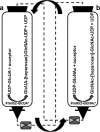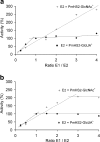Synthesis of heparosan oligosaccharides by Pasteurella multocida PmHS2 single-action transferases
- PMID: 22198719
- PMCID: PMC3418500
- DOI: 10.1007/s00253-011-3813-2
Synthesis of heparosan oligosaccharides by Pasteurella multocida PmHS2 single-action transferases
Abstract
Pasteurella multocida heparosan synthase PmHS2 is a dual action glycosyltransferase that catalyzes the polymerization of heparosan polymers in a non-processive manner. The two PmHS2 single-action transferases, obtained previously by site-directed mutagenesis, have been immobilized on Ni(II)-nitrilotriacetic acid agarose during the purification step. A detailed study of the polymerization process in the presence of non-equal amounts of PmHS2 single-action transferases revealed that the glucuronyl transferase (PmHS2-GlcUA(+)) is the limiting catalyst in the polymerization process. Using experimental design, it was determined that the N-acetylglucosaminyl transferase (PmHS2-GlcNAc(+)) plays an important role in the control of heparosan chain elongation depending on the number of heparosan chains and the UDP-sugar concentrations present in the reaction mixture. Furthermore, for the first time, the synthesis of heparosan oligosaccharides alternately using PmHS2-GlcUA(+) and PmHS2-GlcNAc(+) is reported. It was shown that the synthesis of heparosan oligosaccharides by PmHS2 single-action transferases do not require the presence of template molecules in the reaction mixture.
Figures







Similar articles
-
Analysis of the polymerization initiation and activity of Pasteurella multocida heparosan synthase PmHS2, an enzyme with glycosyltransferase and UDP-sugar hydrolase activity.J Biol Chem. 2011 Jan 21;286(3):1777-85. doi: 10.1074/jbc.M110.136754. Epub 2010 Nov 17. J Biol Chem. 2011. PMID: 21084307 Free PMC article.
-
In vitro synthesis of heparosan using recombinant Pasteurella multocida heparosan synthase PmHS2.Appl Microbiol Biotechnol. 2010 Feb;85(6):1881-91. doi: 10.1007/s00253-009-2214-2. Epub 2009 Sep 16. Appl Microbiol Biotechnol. 2010. PMID: 19756580 Free PMC article.
-
Donor substrate promiscuity of the N-acetylglucosaminyltransferase activities of Pasteurella multocida heparosan synthase 2 (PmHS2) and Escherichia coli K5 KfiA.Appl Microbiol Biotechnol. 2014 Feb;98(3):1127-34. doi: 10.1007/s00253-013-4947-1. Epub 2013 May 10. Appl Microbiol Biotechnol. 2014. PMID: 23661084 Free PMC article.
-
Production methods for heparosan, a precursor of heparin and heparan sulfate.Carbohydr Polym. 2013 Mar 1;93(1):38-47. doi: 10.1016/j.carbpol.2012.04.046. Epub 2012 May 14. Carbohydr Polym. 2013. PMID: 23465899 Review.
-
Superbeads: immobilization in "sweet" chemistry.Chemistry. 2003 Jan 20;9(2):372-7. doi: 10.1002/chem.200390038. Chemistry. 2003. PMID: 12532285 Review.
Cited by
-
Domain organization of the polymerizing mannosyltransferases involved in synthesis of the Escherichia coli O8 and O9a lipopolysaccharide O-antigens.J Biol Chem. 2012 Nov 2;287(45):38135-49. doi: 10.1074/jbc.M112.412577. Epub 2012 Sep 18. J Biol Chem. 2012. PMID: 22989876 Free PMC article.
-
Chlorovirus PBCV-1 protein A064R has three of the transferase activities necessary to synthesize its capsid protein N-linked glycans.Proc Natl Acad Sci U S A. 2020 Nov 17;117(46):28735-28742. doi: 10.1073/pnas.2016626117. Epub 2020 Nov 2. Proc Natl Acad Sci U S A. 2020. PMID: 33139538 Free PMC article.
-
Domain interactions control complex formation and polymerase specificity in the biosynthesis of the Escherichia coli O9a antigen.J Biol Chem. 2015 Jan 9;290(2):1075-85. doi: 10.1074/jbc.M114.622480. Epub 2014 Nov 24. J Biol Chem. 2015. PMID: 25422321 Free PMC article.
-
Enzymatic Synthesis of Glycans and Glycoconjugates.Adv Biochem Eng Biotechnol. 2021;175:231-280. doi: 10.1007/10_2020_148. Adv Biochem Eng Biotechnol. 2021. PMID: 33052414 Review.
-
Heparin and related polysaccharides: synthesis using recombinant enzymes and metabolic engineering.Appl Microbiol Biotechnol. 2015 Sep;99(18):7465-79. doi: 10.1007/s00253-015-6821-9. Epub 2015 Jul 29. Appl Microbiol Biotechnol. 2015. PMID: 26219501 Free PMC article. Review.
References
-
- Box GEP, Draper NR. Empirical model building and response surfaces. New York: Wiley; 1987.
Publication types
MeSH terms
Substances
LinkOut - more resources
Full Text Sources
Other Literature Sources

